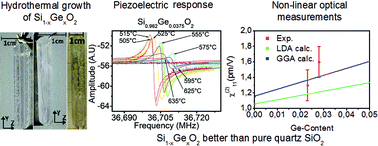Piezoelectric and non-linear optical properties of α-quartz type Si1−xGexO2 single crystals†
Abstract
Single crystals of α-quartz type Si1−xGexO2 with x < 0.2 were grown in 0.05 M NaOH solution. Infrared measurements confirmed that crystals grown at high pressure and high temperature have a low –OH group defect content. After a few millimeters of crystal growth under these conditions, α3500 reaches 0.1 cm−1 and no free –OH are present. The d11 value measured on an X-cut from the crystal with x = 0.0375 is 3.08 pC N−1 (±0.15), in good agreement with the value of 2.97 pC N−1 obtained using density functional theory based calculations. Piezoelectric measurements were performed on the Si1−xGexO2 crystal with x = 0.0375, both at room temperature and after annealing at various temperatures. The piezoelectric signal of the crystal with x = 0.0375 and pure SiO2 disappears after annealing at 635 °C and 545 °C, respectively. Nonlinear optical (NLO) properties of Si1−xGexO2 crystals were measured by Maker's fringe technique on Z-cut χ11(2) and their corresponding values for x = 0.023 and 0.028 are 1.3(2) pm V−1 and 1.6(2) pm V−1, respectively. These values are in good agreement with density functional theory based calculations. The light induced damage threshold values measured on Si1−xGexO2 crystals with x = 0.023 and 0.028 are very similar to that of α-quartz.



 Please wait while we load your content...
Please wait while we load your content...